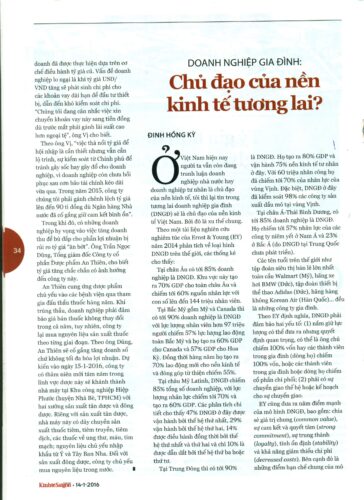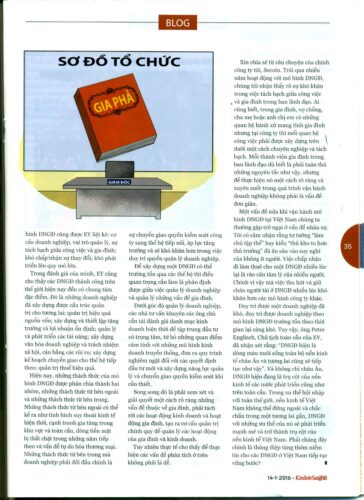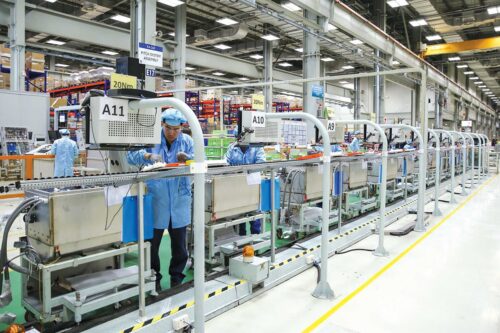Article by Mr. Dinh Hong Ky, published in Saigon Economic Times on January 14, 2016. According to a serious research document by Ernst & Young (EY) in 2014 analyzing the type of family businesses in the world, statistics show that: In Europe, up to 85% of businesses are family businesses. This area generates 70% of GDP for the whole of Europe and accounts for 60% of human resources with a number of up to 144 million employees.

According to a serious research document by Ernst & Young (EY) in 2014 analyzing the type of family businesses in the world, statistics show that:
In Europe, up to 85% of businesses are family businesses. This region generates 70% of GDP for the whole of Europe and accounts for 60% of human resources with a number of up to 144 million employees.
In North America including the US and Canada, up to 90% of businesses are family businesses with a workforce of more than 97 million people, accounting for 57% of the workforce of the whole of North America and they generate 60% of GDP for Canada and 57% of GDP for the United States. At the same time, they annually create 70% of new workers for the economy and contribute 55% to charity.
In Latin America, family businesses account for 85% of the total number of businesses, with a workforce of up to 70% and generate 60% of GDP. Detailed analysis shows that 47% of family businesses here are run by the first generation, 29% by the second generation, 14% by both the first and second generations, and only 10% are led by the third or fourth generation.
In the Middle East, up to 90% are family businesses. They generate 80% of GDP and operate 75% of the private economy here. With 60 million workers, they account for 70% of the workforce in the Gulf. Notably, family businesses here control 98% of oil production companies in the Gulf.
In Asia-Pacific, up to 85% of businesses are family businesses. They account for 57% of the workforce of listed companies in South Asia and 23% in North Asia (because family businesses in China are not yet developed).
World-famous names such as the world’s largest retail supermarket group Walmart (USA), car company BMW (Germany), sports equipment group Adidas (Germany), airline Korean Air (Korea)… are all family companies.
According to EY’s definition, a family-owned enterprise must ensure two factors: (1) holding a force that can make important decisions, which can be the boss holding 100% of the capital or family members (clan) holding 100% of the capital, or family members or clan holding controlling shares; (2) there must be a generational transfer or a plan for the transfer.

EY also listed five strengths of the family business model, including: common value, strong commitment, loyalty, stability and reduced costs. In addition, EY also listed common limitations of the family business model: business structure, management role, separation between work and family; difficulty accepting change; difficulty developing to a large scale.
In its assessment, EY also showed that successful family businesses in the world today share eight common characteristics. These are businesses that have built a governance structure for the future; effectively managed capital; built and established stable growth and profits; managed and developed talents; built corporate culture and social responsibility, balanced risks; built a transfer plan for the next generation; and effective tax management.
Currently, the challenges of the family business model are divided into two groups, external challenges and internal challenges. External challenges include the current economic downturn, increased regional and global competition, tightening cash flow in the coming years and trade liberalization. Internal challenges that businesses must face include the transfer of control of the company to the next generation, growth pressures and increasing difficulty in maintaining business management rights.
To build a family business that can last through generations, it is important to distinguish between managing the business and managing family issues.
From a business management perspective, consultants advise business owners to re-evaluate their current business portfolio to focus on targeted investments, abandon emotional views of traditional business models, establish rigorous processes for new investment decisions, and build management capacity and transfer control when necessary.
At the same time, it is necessary to clearly consider and resolve family issues, separate business activities and family activities, and create a formal governance structure to manage family and business activities.
However, in reality, implementing the above analysis is not easy.

Let me share from my own company, Secoin. After many years of operating with the family enterprise model, we clearly see the difficulty in separating work and family in the leadership. Everyone knows that in the family, husband and wife, parents or siblings have family-like relationships, but in the company, work relationships must be built professionally and separately. Although each family member in the leadership knows that they must comply with such principles, to implement them clearly and consistently during the business operation process is not a simple matter.
Another problem when operating the family enterprise model in Vietnam, we often encounter obstacles in human resources. I feel that the idea of ”collective ownership” or the type of “the warehouse keeper is bigger than the boss” has been deeply ingrained in the thinking of many people. Accepting to work for a family enterprise is sometimes a psychological barrier for many people.
That is why attracting and retaining talent in family-owned enterprises is sometimes more difficult than other corporate models. Maintaining a business is difficult, maintaining a family-owned enterprise model that lasts over time is even more difficult. However, Mr. Peter Englisch, Global Chairman of EY, commented that: “Family-owned enterprises are currently the lifeblood of the entire European economy and will continue to be so in the future”. And not only in Europe, family-owned enterprises are currently the pillars of the economies of developed countries as well as globally. In the trend of integration with the whole world, the Vietnamese economy cannot stand aside and certainly in the near future, family-owned enterprises with their advantages will develop strongly and become the pillars of the Vietnamese economy. Is this the message to increase confidence for family-owned enterprises in Vietnam to continue to move forward?


